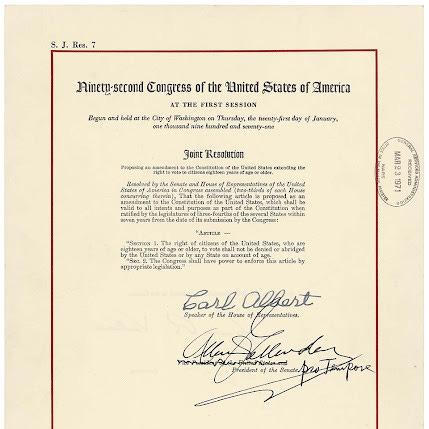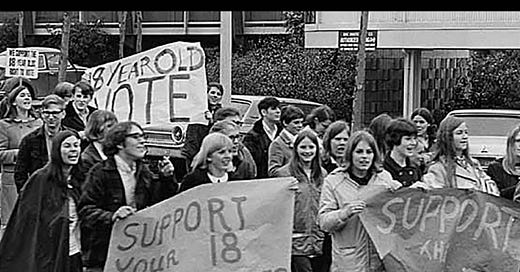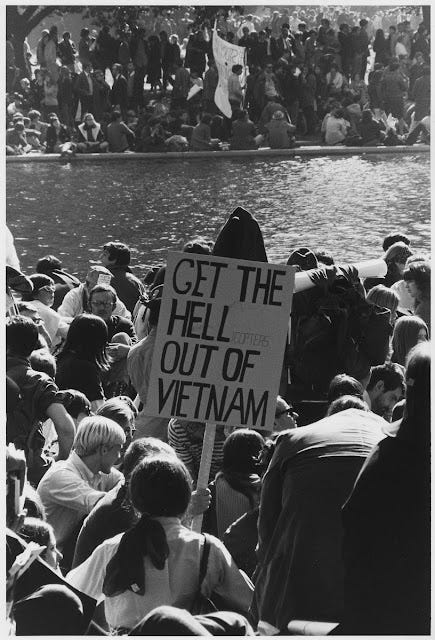The 26th Amendment to the U.S. Constitution lowered the voting age from 21 to 18. This change gave millions of young Americans the right to vote in all elections. It became law on July 1, 1971, after years of protests and political debates.
Before 1971, most states set the voting age at 21. This rule had been in place for many years, but during the 1960’s, young people began demanding a change.
The push for this amendment was closely tied to the Vietnam War, where young people were being drafted (forced into military service) but were not allowed to vote for the leaders sending them into combat. The U.S. government was drafting men as young as 18 to fight in the war, yet they had no say in choosing the politicians making war decisions. This situation led to the slogan, "Old enough to fight, old enough to vote."
The idea of lowering the voting age had been discussed before. During World War II, President Franklin D. Roosevelt lowered the draft age from 21 to 18. Some leaders at the time believed that if young people were old enough to fight, they should also be allowed to vote. However, no law was passed to change the voting age at that time.
The Role of the Youth Rights Movement
During the 1960’s, young people became more politically active. Many joined protests against racial discrimination, war, and government policies. The Civil Rights Movement inspired young activists to push for equal rights, including voting rights for 18-year-old’s.
The Student Nonviolent Coordinating Committee (SNCC) and other youth-led organizations helped raise awareness about voting rights. College students held marches, wrote letters to politicians, and spoke out about the unfairness of being drafted but not being able to vote.
Additionally, the Vietnam War was deeply unpopular among many young Americans. By the late 1960’s, thousands of U.S. soldiers had died in combat, and many more were wounded. Television broadcasts brought the war into American homes, making people more aware of its horrors.

Young people felt they should have a say in electing leaders who made war decisions. Their argument gained support from politicians, civil rights leaders, and even President Richard Nixon, who signed the 26th Amendment into law in 1971.
The amendment was ratified (formally approved) by the states faster than any other amendment in U.S. history. Within just three months, it became law.
The Impact of the 26th Amendment
Before the amendment was passed, some states had already begun lowering the voting age. However, these changes led to legal challenges.
One important case was Oregon v. Mitchell (1970). In this case, the Supreme Court ruled that Congress could set the voting age for federal elections (such as for president and Congress) but not for state and local elections. This created confusion, as young people could vote in some elections but not others. The ruling made it clear that a constitutional amendment was needed to lower the voting age nationwide.
Once the 26th Amendment was ratified, millions of young Americans gained the right to vote. In the 1972 presidential election, over 50% of newly eligible 18- to 20-year-old’s cast their votes. Although youth voter turnout has gone up and down over the years, young voters continue to play an important role in elections.

This amendment also reinforced the idea that voting rights should be expanded, not restricted. It was a victory for the youth rights movement and a reminder that political activism can lead to real change.
The 26th Amendment was a landmark achievement in American history. It gave young people a voice in government, ensuring that those old enough to serve in the military could also participate in democracy. The youth movements of the 1960’s proved that activism and public pressure could change the law, leaving a lasting impact on the nation.
Sources and Additional Reading
The U.S. Constitution: National Archives
Oregon v. Mitchell (1970): Oyez
History of the 26th Amendment: Library of Congress
The Vietnam War and Voting Rights: Smithsonian Magazine
Youth Voting and Civic Engagement: Brookings Institution
The Impact of the 26th Amendment: Brennan Center for Justice




